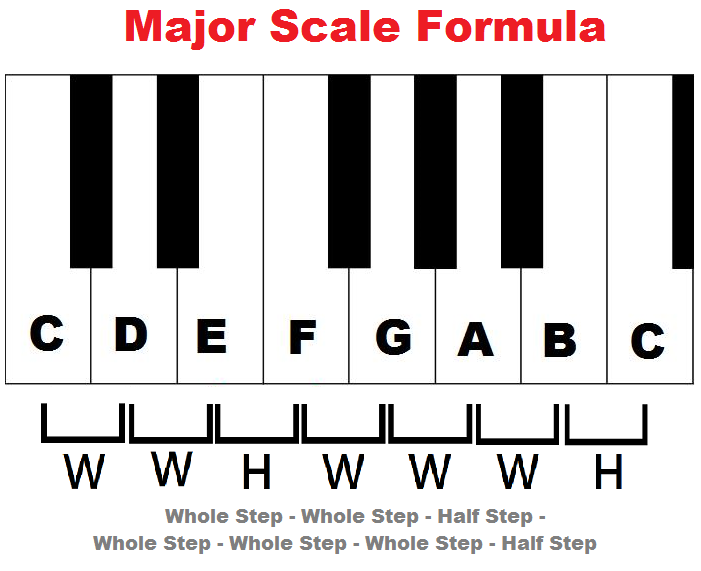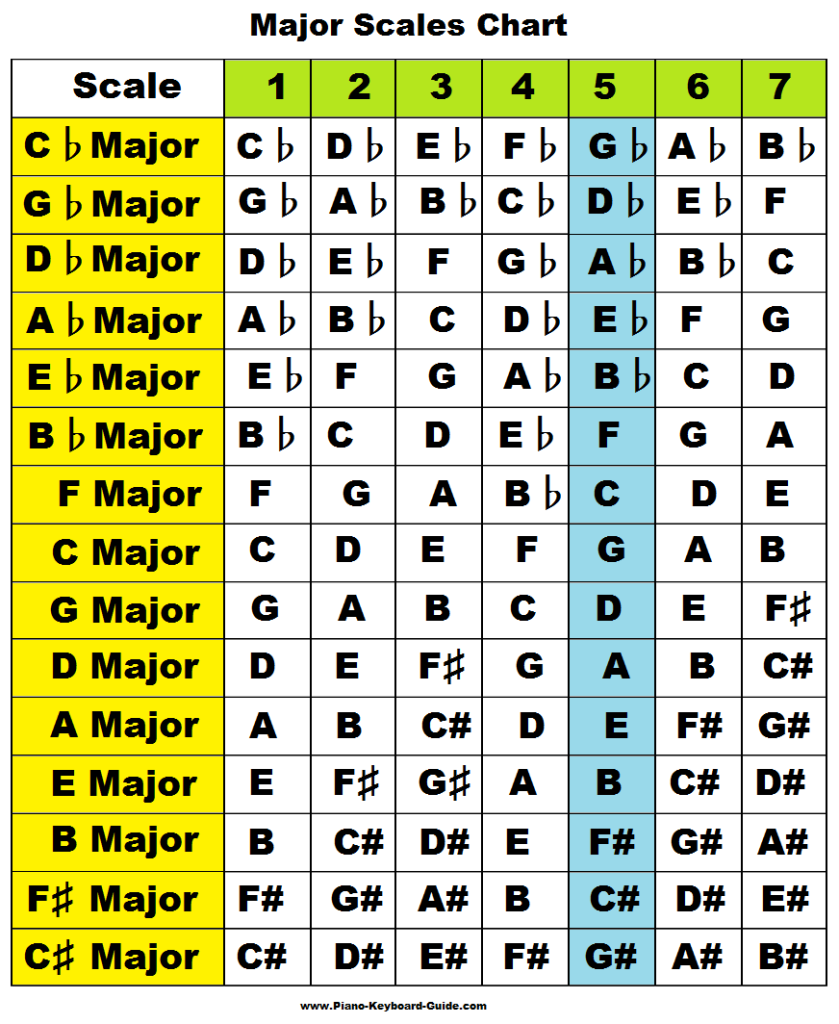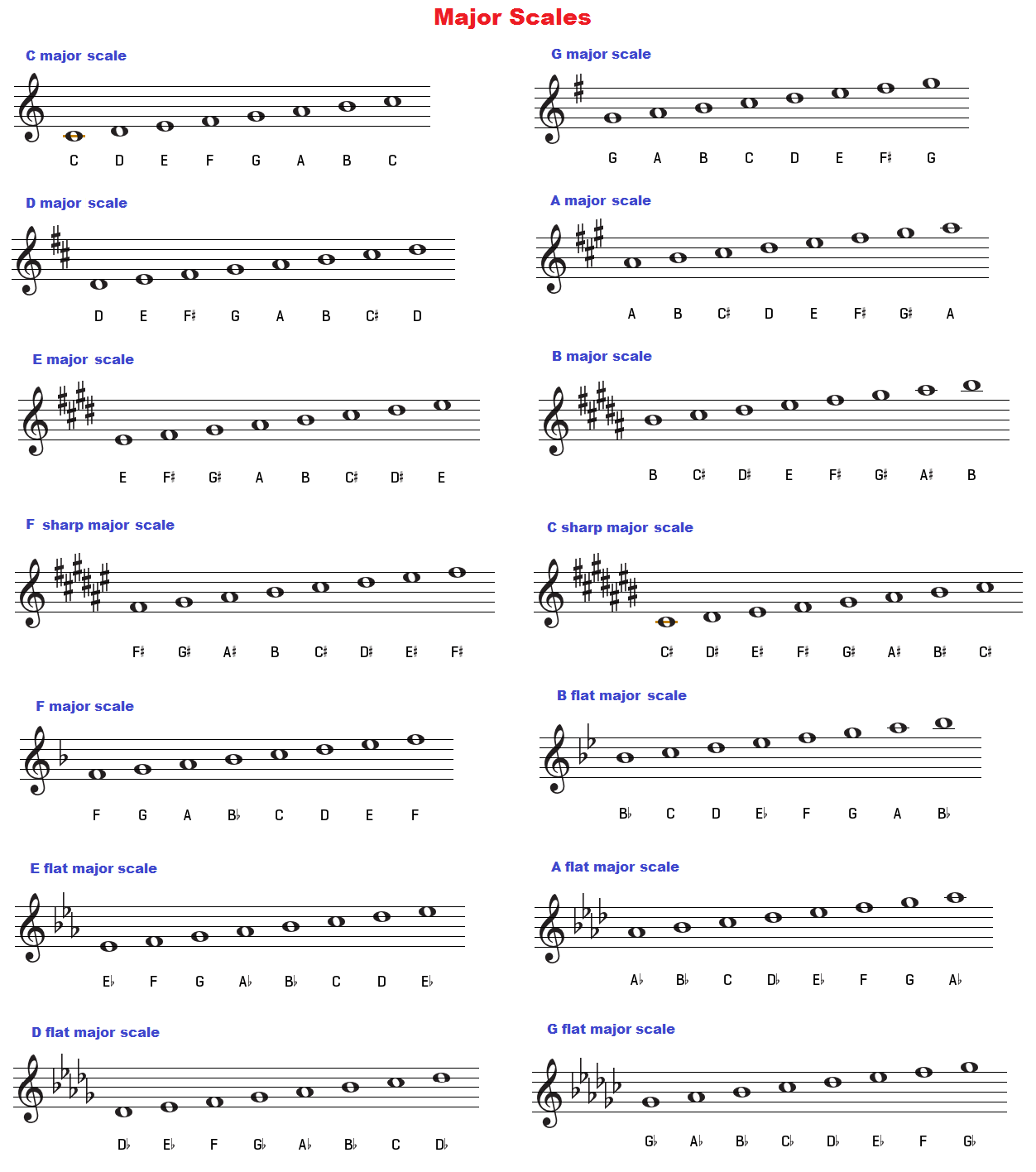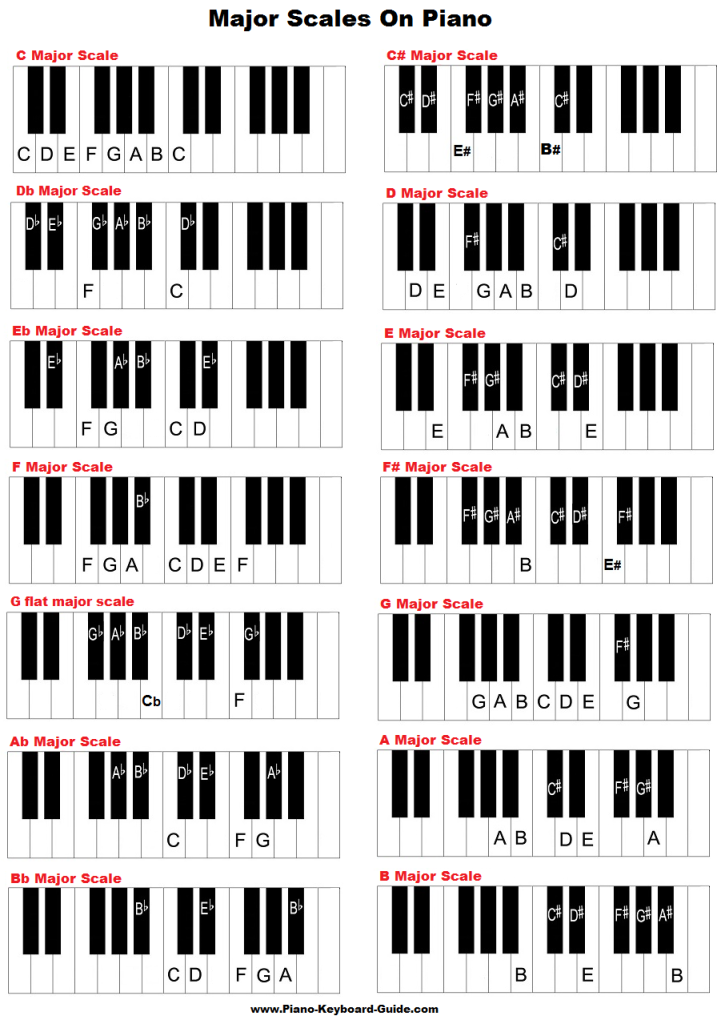In this lesson, we will learn all about major scales. This diatonic scale is one of the most commonly used scales and is the first one you should learn as a piano or music student. It is made up of seven notes.
The simplest major scale to write is C major, because it requires no sharps or flats. This scale is also very easy to form on piano and keyboard because it makes use of white keys only. Its notes are C, D, E, F, G, A, B and C. Of course, the last C, the eighth note is a duplicate note, one octave higher.
My Best Recommendation: Click here for the BEST piano/keyboard course I’ve seen on the Internet.
Note Pattern (Scale Formula)
The pattern of notes for major scales is W-W-H-W-W-W-H(whole – whole – half – whole – whole – whole – half). This stands for whole step, whole step, half step, whole step, whole step, whole step, half step.
What do we mean by whole steps and half steps? Whole steps and half steps represent the distance between notes. For example, the distance between E and F is a half step. The distance between B and C is also a half step. Take a look at your piano keyboard. You will realize that there is no key between E and F and between B and C. Two more examples of half steps (also called semitones) are the distance between C and C sharp and D and D flat.
As for whole steps (or whole tones) they always skip a key. C to D is a whole step, D to E is a whole step and so on.
As long as you know the major scale formula, you can start on any note or key and form a major scale.
Starting on C, go up a whole step to D, a whole step to E, a half step to F, a whole step to G, a whole step to A, a whole step to B and lastly, a half step to C.
My new book, Piano Scales Made Simple, will help you with your scales. Go here to get it at a discounted price.
Let’s try this with the note G. Go to your piano keyboard and follow the W-W-H-W-W-W-H pattern. You will notice that the notes of the G major scale are G, A, B, C, D, E, F# and G. For the sake of those who are not sure about the notes of the piano keyboard, you can find out here.
There are 12 different Major Scales: One with no sharps or flats, 4 with sharps, 4 with flats, and 3 with either sharps or flats depending upon their enharmonic spelling.
List of Major Scales
Here are the major scales in all keys listed in Circle of Fifths order.
- C major scale: C – D – E – F – G – A – B – C
- G: G – A – B – C – D – E – F# – G
- D: D – E – F# – G – A – B – C# – D
- A: A – B – C# – D – E – F# – G# – A
- E: E – F# – G# – A – B – C# – D# – E
- B: B – C# – D# – E – F# – G# – A# – B
- F#: F# – G# – A# – B – C# – D# – E# (=F) – F#
- Gb: Gb – Ab – Bb – Cb (=B) – Db – Eb – F – Gb
- Db: Db – Eb – F – Gb – Ab – Bb – C – Db
- C#: C# – D# – E# (=F) – F# – G# – A# – B# (=C) – C#
- Ab: Ab – Bb – C – Db – Eb – F – G – Ab
- Eb: Eb – F – G – Ab – Bb – C – D – Eb
- Bb: Bb – C – D – Eb – F – G – A – Bb
- F: F – G – A – Bb – C – D – E – F

Scale Degrees
The scale degrees are as follows:
- 1st – Tonic- key note
- 2nd – Supertonic
- 3rd – Mediant
- 4th – Subdominant
- 5th – Dominant
- 6th – Submediant
- 7th – Leading tone
- 8th – Tonic ( or Octave)
Key Signatures
As for the key signatures of the above scales, they are as follows:
- C major has no sharps or flats.
- G major has 1 sharp.
- D major has 2 sharps.
- A major has 3 sharps.
- E major has 4 sharps.
- B major has 5 sharps.
- F# major has 6 sharps. Gb major has 6 flats.
- Db major has 5 flats. C# major has 7 sharps.
- Ab major has 4 flats.
- Eb major has 3 flats.
- Bb major has 2 flats.
- F major has 1 flat.
Video:
Relative Minors
Relative Minors of major scales/keys are based on the 6th note of the scale. They are as follows:
- C – A minor
- G – E minor
- D – B minor
- A – F sharp minor
- E – C sharp minor
- B – G sharp minor
- F# – D sharp minor (Gb – E flat minor)
- Db – B flat minor (C# – A sharp minor)
- Ab – F minor
- Eb – C minor
- Bb – G minor
- F – D minor
Major scales consist of the same notes as their relative minor scales.
Chords By Key (Diatonic Triads in Each Major Scale)
Let’s now take a look at diatonic triads in each scale. In other words, these are chords by key (Chords in the key of C, G, D, A, E, B, F#, Db, Ab, Eb, Bb and F.)
- C: C – Dm – Em – F – G – Am – Bdim
- G: G – Am – Bm – C – D – Em – F#dim
- D: D – Em – F#m – G – A – Bm – C#dim
- A: A – Bm – C#m – D – E – F#m – G#dim
- E: E – F#m – G#m – A – B – C#m – D#dim
- B: B – C#m – D#m – E – F# – G#m – A#dim
- F#: F# – G#m – A#m – B – C# – D#m – E#dim
- Db: Db – Ebm – Fm – Gb – Ab – Bbm – Cdim
- Ab: Ab – Bbm – Cm – Db – Eb – Fm – Gdim
- Eb: Eb – Fm – Gm – Ab – Bb – Cm – Ddim
- Bb: Bb – Cm – Dm – Eb – F – Gm – Adim
- F: F – Gm – Am – Bb – C – Dm – Edim
Keyboard & Piano Fingerings For Major Scales
- Notes: C, D, E, F, G, A, B, C
- Fingerings (LH): 5, 4, 3, 2, 1, 3, 2, 1
- Fingerings (RH): 1, 2, 3, 1, 2, 3, 4, 5
- Notes: D, E, F#, G, A, B, C#, D
- Fingerings (LH): 5, 4, 3, 2, 1, 3, 2, 1
- Fingerings (RH): 1, 2, 3, 1, 2, 3, 4, 5
- Notes: E, F#, G#, A, B, C#, D#, E
- Fingerings (LH): 5, 4, 3, 2, 1, 3, 2, 1
- Fingerings (RH): 1, 2, 3, 1, 2, 3, 4, 5
- Notes: F, G, A, Bb, C, D, E, F
- Fingerings (LH): 5, 4, 3, 2, 1, 3, 2, 1
- Fingerings (RH): 1, 2, 3, 4, 1, 2, 3, 4
- Notes: G, A, B, C, D, E, F#, G
- Fingerings (LH): 5, 4, 3, 2, 1, 3, 2, 1
- Fingerings (RH): 1, 2, 3, 1, 2, 3, 4, 5
- Notes: A, B, C#, D, E, F#, G#, A
- Fingerings (LH): 5, 4, 3, 2, 1, 3, 2, 1
- Fingerings (RH): 1, 2, 3, 1, 2, 3, 4, 5
- Notes: B, C#, D#, E, F#, G#, A#, B
- Fingerings (LH): 4, 3, 2, 1, 4, 3, 2, 1
- Fingerings (RH): 1, 2, 3, 1, 2, 3, 4, 5
- Notes: Db, Eb, F, Gb, Ab, Bb, C, Db
- Fingerings (LH): 3, 2, 1, 4, 3, 2, 1, 3
- Fingerings (RH): 2, 3, 1, 2, 3, 4, 1, 2
- Notes: Eb, F, G, Ab, Bb, C, D, Eb
- Fingerings (LH): 3, 2, 1, 4, 3, 2, 1, 3
- Fingerings (RH): 3, 1, 2, 3, 4, 1, 2, 3
- Notes: F#, G#, A#, B, C#, D#, F, F#
- Fingerings (LH): 4, 3, 2, 1, 3, 2, 1, 4
- Fingerings (RH): 2, 3, 4, 1, 2, 3, 1, 2
- Notes: Ab, Bb, C, Db, Eb, F, G, Ab
- Fingerings (LH): 3, 2, 1, 4, 3, 2, 1, 3
- Fingerings (RH): 3, 4, 1, 2, 3, 1, 2, 3
- Notes: Bb, C, D, Eb, F, G, A, Bb
- Fingerings (LH): 3, 2, 1, 4, 3, 2, 1, 3
- Fingerings (RH): 4, 1, 2, 3, 1, 2, 3, 4
Fingerings: 1 = Thumb, 2 = index finger, 3 = middle finger, 4 = ring finger, 5 = little finger. LH = Left hand, RH = Right hand.
Piano scales: Learn how to form other scales on piano and keyboard including natural, melodic and harmonic minor, pentatonic, blues and whole tone scales.
How to Form Minor and Major Scales on Piano
Learn to play piano and keyboard with Piano For All.
Piano Keyboard Guide Home Page

